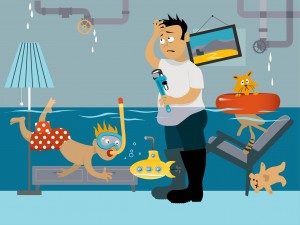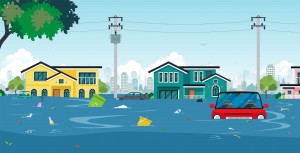While most people might assume their homeowners’ insurance covers events like a flood or water damage issue, it usually does not. For example, most homeowners’ policies would cover the damage caused by frozen pipes, but not the pipe itself. However, in instances like heavy water backup into the home or flooding, homeowners’ policies can leave your clients unprotected.
With rainfall this season reaching highs, it is more important than ever to check in with your clients and see what additional policies they might need to be fully covered from these events. Understanding the difference between Water Backup Coverage and Flood Insurance will help you help them best.
Water Backup Coverage
Water backup coverage would kick in regarding water backup into a home from an outside drain or sewer that connects the homeowner’s property to the city system. This can be added to homeowner’s policies to provide additional protection against damage caused by these events.
It can cover the damages associated with sudden and accidental water issues, such as if a water heater bursts or a pipe ruptures and things like flooring and drywall then need to be replaced.
It does not cover:
- Damage caused by neglect of maintenance issues
- Replacing or repairing the source of the water damage (ex. the pipe or water heater involved)
- Flooding
Flood Insurance
First, what is the definition of a flood?
According to the National Flood Insurance Program, a flood is a general and temporary condition where two or more acres of normally dry land or two or more properties are inundated by water or mudflow.
Flooding can happen anywhere, but certain areas are more prone to serious flooding. Before choosing a policy, understanding the risk to the specific property can ensure that enough coverage is purchased.
What is flood insurance?
In the event of a flood, this coverage covers direct physical losses to your home and belongings as result of the flooding.
Some policies divide coverage into two categories- Building coverage and Contents coverage.
Building coverage protects things like:
- Electrical and plumbing systems
- Built-in Appliances, such as furnaces, water heaters, cooking stoves, refrigerators
- Foundation, walls, staircases, flooring
- Permanently installed home features, such as cabinets, blinds, etc.
- Detached garages
- Fuel tanks, well water tanks or pumps, etc.
Contents Coverage covers things like:
- Personal belongings like clothes, furniture, equipment
- Appliances that are not permanent (ex. microwave, window air conditioners, washer and dryer)
- Some valuable personal items, which can also be supplemented with personal property coverage
What isn’t covered?
The cause of the flooding matters to the claim. Again, a flood is an excess of water in land that is normally dry and it must affect more than two acres of land and multiple properties to be considered a flood.
This is why adding Water Backup Coverage can cover the bases that flood insurance does not.
Encourage clients to create a home inventory
A great practice for every person is to create a home inventory to help with claims in the event of any disaster. There are some great apps for this, such as Sortly, Nest Egg, or Momento Database.
Encouraging your clients to do this is good planning, an exercise of mindfulness of why their coverage can help them survive a disaster, and an important step to understanding the coverage limits that might work best for their life.
Please contact MIBS personal insurance specialist Nancy Trafford at nancy@midwestga.com with any questions.


Leave A Comment
You must be logged in to post a comment.